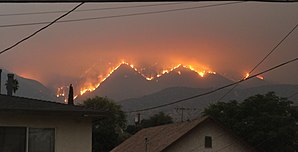Courtesy : en.wikipedia.org
Climate change
in common usage, climate change describes global warming—the ongoing increase in global average temperature—and its effects on Earth’s climate system. Climate change in a broader sense also includes previous long-term changes to Earth’s climate. The current rise in global average temperature is more rapid than previous changes, and is primarily caused by humans burning fossil fuels.Fossil fuel use, deforestation, and some agricultural and industrial practices increase greenhouse gases, notably carbon dioxide and methane. Greenhouse gases absorb some of the heat that the Earth radiates after it warms from sunlight. Larger amounts of these gases trap more heat in Earth’s lower atmosphere, causing global warming.
Due to climate change, deserts are expanding, while heat waves and wildfires are becoming more common. Increased warming in the Arctic has contributed to melting permafrost, glacial retreat and sea ice loss Higher temperatures are also causing more intense storms, droughts, and other weather extremes. Rapid environmental change in mountains, coral reefs, and the Arctic is forcing many species to relocate or become extinct. Even if efforts to minimise future warming are successful, some effects will continue for centuries. These include ocean heating, ocean acidification and sea level rise.
Climate change threatens people with food and water scarcity, increased flooding, extreme heat, more disease, and economic loss. Human migration and conflict can also be a result The World Health Organization (WHO) calls climate change the greatest threat to global health in the 21st century.Communities may adapt to climate change through efforts like coastline protection or expanding access to air conditioning, but some impacts are unavoidable. Poorer countries are responsible for a small share of global emissions, yet they have the least ability to adapt and are most vulnerable to climate change.
Many climate change impacts are already felt at the current 1.2 °C (2.2 °F) level of warming. Additional warming will increase these impacts and may trigger tipping points, such as the melting of the Greenland ice sheet. Under the 2015 Paris Agreement, nations collectively agreed to keep warming “well under 2 °C”. However, with pledges made under the Agreement, global warming would still reach about 2.7 °C (4.9 °F) by the end of the century. Limiting warming to 1.5 °C will require halving emissions by 2030 and achieving net-zero emissions by 2050.


![A dry lakebed in California, which is experiencing its worst megadrought in 1,200 years.[15]](https://upload.wikimedia.org/wikipedia/commons/thumb/d/d3/California_Drought_Dry_Lakebed_2009.jpg/129px-California_Drought_Dry_Lakebed_2009.jpg)
Some effects of climate change, clockwise from top left: Wildfire intensified by heat and drought, worsening droughts compromising water supplies, and bleaching of coral caused by marine heatwaves.
Reducing emissions requires generating electricity from low-carbon sources rather than burning fossil fuels. This change includes phasing out coal and natural gas fired power plants, vastly increasing use of wind, solar, and other types of renewable energy, and reducing energy use. Electricity generated from non-carbon-emitting sources will need to replace fossil fuels for powering transportation, heating buildings, and operating industrial facilities.Carbon can also be removed from the atmosphere, for instance by increasing forest cover and by farming with methods that capture carbon in soil.
Terminology
Before the 1980s, when it was unclear whether the warming effect of increased greenhouse gases were stronger than the cooling effect of airborne particulates in air pollution, scientists used the term inadvertent climate modification to refer to human impacts on the climate.
In the 1980s, the terms global warming and climate change became more common. Though the two terms are sometimes used interchangeably, scientifically, global warming refers only to increased surface warming, and climate change describes the full effect of greenhouse gases on Earth’s climate system.Global warming—used as early as 1975—became the more popular term after NASA climate scientist James Hansen used it in his 1988 testimony in the U.S. Senate.Since the 2000s, climate change has increased in usage. Climate change can also refer more broadly to both human-caused changes or natural changes throughout Earth’s history.
Various scientists, politicians and media now use the terms climate crisis or climate emergency to talk about climate change, and global heating instead of global warming.
Observed temperature rise
Main articles: Temperature record of the last 2,000 years and Instrumental temperature record
Global surface temperature reconstruction over the last 2000 years using proxy data from tree rings, corals, and ice cores in blue. Directly observed data is in red.
Multiple independent instrumental datasets show that the climate system is warming.The 2011–2020 decade warmed to an average 1.09 °C [0.95–1.20 °C] compared to the pre-industrial baseline (1850–1900). Surface temperatures are rising by about 0.2 °C per decade, with 2020 reaching a temperature of 1.2 °C above the pre-industrial era.Since 1950, the number of cold days and nights has decreased, and the number of warm days and nights has increased.
There was little net warming between the 18th century and the mid-19th century. Climate information for that period comes from climate proxies, such as trees and ice cores. Thermometer records began to provide global coverage around 1850. Historical patterns of warming and cooling, like the Medieval Climate Anomaly and the Little Ice Age, did not occur at the same time across different regions. Temperatures may have reached as high as those of the late-20th century in a limited set of regions.There have been prehistorical episodes of global warming, such as the Paleocene–Eocene Thermal Maximum.However, the modern observed rise in temperature and CO2 concentrations has been so rapid that even abrupt geophysical events in Earth’s history do not approach current rates.
Evidence of warming from air temperature measurements are reinforced with a wide range of other observations. For example, changes to the natural water cycle have been predicted and observed, such as an increase in the frequency and intensity of heavy precipitation, melting of snow and land ice, and increased atmospheric humidity. Flora and fauna are also behaving in a manner consistent with warming; for instance, plants are flowering earlier in spring.Another key indicator is the cooling of the upper atmosphere, which demonstrates that greenhouse gases are trapping heat near the Earth’s surface and preventing it from radiating into space.
Regional aspects to temperature rises
See also: Climate variability and change § Variability between regions
Regions of the world warm at differing rates. The pattern is independent of where greenhouse gases are emitted, because the gases persist long enough to diffuse across the planet. Since the pre-industrial period, the average surface temperature over land regions has increased almost twice as fast as the global-average surface temperature. This is because of the larger heat capacity of oceans, and because oceans lose more heat by evaporation.The thermal energy in the global climate system has grown with only brief pauses since at least 1970, and over 90% of this extra energy has been stored in the ocean.The rest has heated the atmosphere, melted ice, and warmed the continents
The Northern Hemisphere and the North Pole have warmed much faster than the South Pole and Southern Hemisphere. The Northern Hemisphere not only has much more land, but also more seasonal snow cover and sea ice. As these surfaces flip from reflecting a lot of light to being dark after the ice has melted, they start absorbing more heat.Local black carbon deposits on snow and ice also contribute to Arctic warming.Arctic temperatures are increasing at over twice the rate of the rest of the world. Melting of glaciers and ice sheets in the Arctic disrupts ocean circulation, including a weakened Gulf Stream, further changing the climate.
Attribution of recent temperature rise
Main article: Attribution of recent climate change
Drivers of climate change from 1850–1900 to 2010–2019. There was no significant contribution from internal variability or solar and volcanic drivers.
The climate system experiences various cycles on its own which can last for years (such as the El Niño–Southern Oscillation (ENSO)), decades or even centuries.Other changes are caused by an imbalance of energy that is “external” to the climate system, but not always external to the Earth. Examples of external forcings include changes in the concentrations of greenhouse gases, solar luminosity, volcanic eruptions, and variations in the Earth’s orbit around the Sun.
To determine the human contribution to climate change, known internal climate variability and natural external forcings need to be ruled out. A key approach is to determine unique “fingerprints” for all potential causes, then compare these fingerprints with observed patterns of climate change.For example, solar forcing can be ruled out as a major cause. Its fingerprint would be warming in the entire atmosphere. Yet, only the lower atmosphere has warmed, consistent with greenhouse gas forcing.Attribution of recent climate change shows that the main driver is elevated greenhouse gases, with aerosols having a dampening effect.
Greenhouse gases
Main articles: Greenhouse gas, Greenhouse gas emissions, Greenhouse effect, and Carbon dioxide in Earth’s atmosphere
CO2 concentrations over the last 800,000 years as measured from ice cores (blue/green) and directly (black)
Greenhouse gases are transparent to sunlight, and thus allow it to pass through the atmosphere to heat the Earth’s surface. The Earth radiates it as heat, and greenhouse gases absorb a portion of it. This absorption slows the rate at which heat escapes into space, trapping heat near the Earth’s surface and warming it over time. Before the Industrial Revolution, naturally-occurring amounts of greenhouse gases caused the air near the surface to be about 33 °C warmer than it would have been in their absence.While water vapour (~50%) and clouds (~25%) are the biggest contributors to the greenhouse effect, they increase as a function of temperature and are therefore feedbacks. On the other hand, concentrations of gases such as CO2 (~20%), tropospheric ozone, CFCs and nitrous oxide are not temperature-dependent, and are therefore external forcings.
Human activity since the Industrial Revolution, mainly extracting and burning fossil fuels (coal, oil, and natural gas), has increased the amount of greenhouse gases in the atmosphere, resulting in a radiative imbalance. In 2019, the concentrations of CO2 and methane had increased by about 48% and 160%, respectively, since 1750.These CO2 levels are higher than they have been at any time during the last 2 million years. Concentrations of methane are far higher than they were over the last 800,000 years.
The Global Carbon Project shows how additions to CO2 since 1880 have been caused by different sources ramping up one after another.
Global anthropogenic greenhouse gas emissions in 2019 were equivalent to 59 billion tonnes of CO2. Of these emissions, 75% was CO2, 18% was methane, 4% was nitrous oxide, and 2% was fluorinated gases.CO2 emissions primarily come from burning fossil fuels to provide energy for transport, manufacturing, heating, and electricity.Additional CO2 emissions come from deforestation and industrial processes, which include the CO2 released by the chemical reactions for making cement, steel, aluminum, and fertiliser. Methane emissions come from livestock, manure, rice cultivation, landfills, wastewater, and coal mining, as well as oil and gas extraction. Nitrous oxide emissions largely come from the microbial decomposition of fertiliser.
Despite the contribution of deforestation to greenhouse gas emissions, the Earth’s land surface, particularly its forests, remain a significant carbon sink for CO2. Land-surface sink processes, such as carbon fixation in the soil and photosynthesis, remove about 29% of annual global CO2 emissions. The ocean also serves as a significant carbon sink via a two-step process. First, CO2 dissolves in the surface water. Afterwards, the ocean’s overturning circulation distributes it deep into the ocean’s interior, where it accumulates over time as part of the carbon cycle. Over the last two decades, the world’s oceans have absorbed 20 to 30% of emitted CO2.




